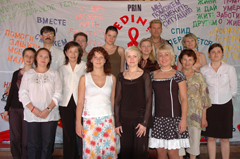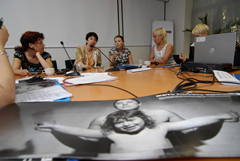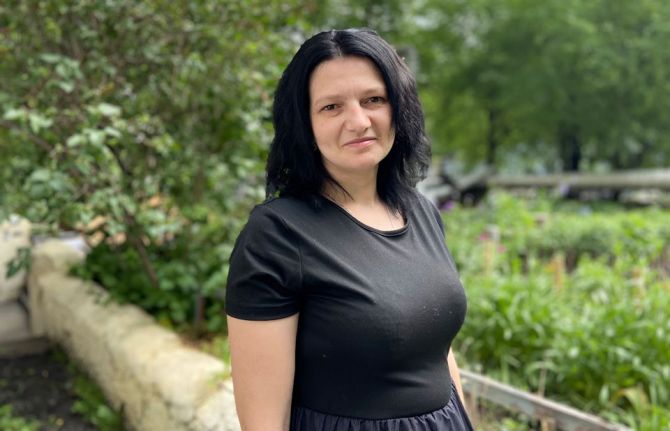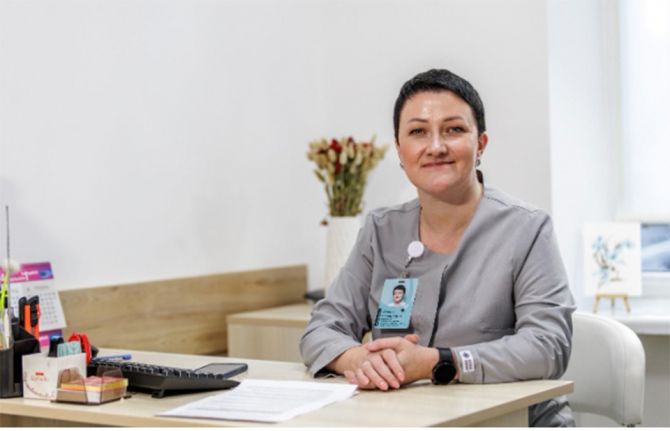
Feature Story
Love, live, dream: women against AIDS in Armenia, Moldova, Kazakhstan, Russia, Ukraine
13 July 2007
13 July 2007 13 July 2007During a nine day tour of five countries of the Commonwealth of Independent States, a group of HIV advocates met with policy makers and civil society organizations to raise awareness on women and AIDS in this part of the world.

Women against AIDS tour was conceived in the
midst of a growing concern that women are
increasingly at risk of HIV infection in many parts of
Eastern Europe and Central Asia.
Women against AIDS tour was conceived in the midst of a growing concern that women are increasingly at risk of HIV infection in many parts of Eastern Europe and Central Asia. The percentage of adults living with HIV who are women has risen from 11% in 1990 to 28% in 2006.
The tour was sponsored by the AIDS Infoshare organization, UNAIDS, the Global Coalition of Women on AIDS and the United Nations Development Program. Ten AIDS advocates from the region with special guests joining at various points travelled together to learn about the realities of women and AIDS in different parts of the region and also to mobilize local policy makers to act on these issues.
In each of the capital cities of Armenia, Moldova, Kazakhstan, Russia, and Ukraine—the tour group joined with civil society organizations and groups of People Living with HIV (PLHIV) to talk about some of the most difficult issues such as stigma and discrimination and their consequences including losing children’s custody, being thrown out of the home and losing jobs.
“These are real issues,” said Deborah Landey, Deputy Executive Director of UNAIDS who joined the last part of the tour. “We have a collective responsibility to make a difference for women ,” she added.
The predominant mode of HIV transmission in the region remains through the use of non-sterile injecting drug equipment. However an increasing proportion of HIV infections — 37% of reported cases in 2005 — are estimated to occur during unprotected sexual intercourse. In Ukraine, the proportion of people infected with HIV through heterosexual transmission increased from 14% of new cases between 1999 and 2003 to over 35% of new cases in the first six months of 2006.
“We must look at every AIDS plan and strategy and ask whether it works for women,” emphasized Ms Landey. “This is our chance to curb the epidemic in this region,” she added.

The Women Against AIDS also produced a set of
issues to be considered and recommendations when
developing national AIDS strategies in the region.
The tour ended where it started, with women. Sergei Golovach a renowned photographer and a guest on the tour took photos of his fellow advocates for an exhibit to be held called Love, Live and Dream. Through portraits h e wanted to emphasize that it does not matter who is HIV-positive.
“Just look at this photo,” said Ms Landey, remarking on one of the portraits of a mother and her daughter that has been turned into an advocacy poster. “It is all about a mother’s love—which has nothing to do with one’s HIV status.”
Moved by these portraits and what she learned from the tour participants, Elena Vasilieva, Editor in Chief of the Russian Cosmopolitan magazine promised to publish an article about the Women Against AIDS tour in the November edition. To help break down stereotypes she said “a glossy magazine is the right place to raise socially important topics.”
The Women Against AIDS also produced a set of issues to be considered and recommendations when developing national AIDS strategies in the region. Highlighting the critical importance of translating these recommendations into actions, Anna Dubrovskaya, from 'Golos anti-SPID' in Russia said “our wonderful recommendations will not work if there is nobody to demand from policy makers that they keep their promises. The most important thing is to not let this initiative die.”
Recommendations of the tour participants
We, the participants of the ‘Women Against AIDS’ project have visited five CIS countries to hold consultations with key stakeholders working in the field of HIV prevention, treatment and care. As a result of these consultations the project participants have developed the recommendations below. We believe that urgent measures should be taken to ensure women’s access to primary HIV prevention as well as access to treatment, care and support.
We would like to highlight a set of recommendations that we feel are of the greatest importance in each of our countries, regardless of differences in the stages of the epidemic or in social and economic development. We urge all interested parties to take these recommendations into consideration when developing national strategies to fight HIV/AIDS.
Specifically, we recommend:
- Implementation of information and education campaigns on primary HIV prevention targeted specifically at women, along with increased efforts to fight stigma and discrimination.
- Further development of programmes aimed at improving the quality of life of HIV-positive women, including programmes to ensure access to medical services not related to ARV treatment and reproductive health.
- Acceleration of programmes to ensure the social protection of HIV positive women.
- Increased research on the gender aspects of the HIV epidemic in Armenia, Kazakhstan, Moldova, Russia and Ukraine.
- Expanded efforts to guarantee the active involvement of women in decision-making processes at all levels.
- Additional state support for women’s initiatives to improve the quality of life of HIV positive women.
- Development of voluntary testing and pre- and post HIV test counseling services.
- Enhanced cooperation between various sectors, government and state organizations and civil society groups including those which are not yet directly involved in HIV prevention activities.
- Increased efforts to ensure respect for a woman’s choice related to reproductive health issues.
- Implementation of further needs assessments on HIV prevention, treatment, care and support for women.
- Support for the introduction of gender specific programmes, including support for the greater development of leadership and activism among women.
27 – 28 May 2007 Almaty (Kazakhstan)
29 - 30 May 2007 Yerevan (Armenia)
30 May - 1 June 2007 Chisinau (Moldova)
2 - 5 June 2007 Kyev (Ukraine)
6 June 2007 Moscow (Russian Federation)
Participants to the ‘Women Against AIDS’ Tour:
- Grekova Anna – ‘All-Ukrainian Network of PLHIV’, Kiev, Ukraine
- Dubrovskaya Anna – NGO ‘Golos-anti-SPID’, Ufa, Russia
- Zavalko Natalia – ‘AIDS infoshare’, Moscow, Russia
- Ivannikova Maria - ‘AIDS infoshare’, Moscow, Russia
- Polozkova Vera – Correspondent for ‘Cosmopolitan’ Magazine, Moscow, Russia
- Skibnevskaya Nina- ‘AIDS infoshare’, Moscow, Russia
- Slepneva Asya – Correspondent of Mayak Radio Station, Moscow, Russia
- Stupak Tatiana – NGO ‘ Victoria’, Pavlodar, Kazakhstan
- Tamazova Elena – UNAIDS, Moscow, Russia
- Untura Lyudmila – NGO ‘Childhood for All’, Chisinau, Moldova
- Golovach Sergei – Photographer, Moscow, Russia
All photo credit: UNAIDS/Serge Golovach
Links:
View photo gallery
Listen to interview with UNAIDS Deputy Executive Director Deborah Landey
Visit the Global coalition on women and AIDS' web site
Visit UNDP's web site
Visit AIDS Info Share's web site



